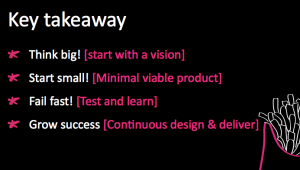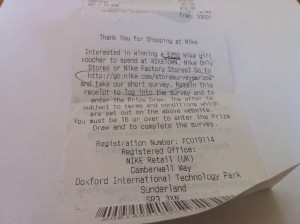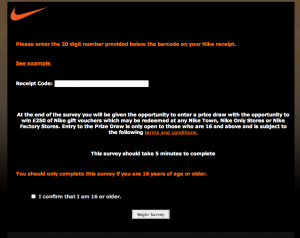In the past couple of years I’ve had the privilege of mentoring at the Lean Startup Machine in London. Saturday morning is when the teams first ‘get out of the building‘ to do customer development. It is easy to preach that mantra of getting out and talking to customers, but how do you do it? How do you get the most out of customer development interviews? What do you say? Here are twelve tips that I’ve presented.
1. Go fish where the fishes swim
I recently heard this from an agency pitching social media work (take your proposition to social networks where your customers are, rather than assuming they’ll come to you) but the statement holds true for customer development. It’s not enough to get out of the building and hope to randomly find people that care. You’ve got to go to where your target market hang out, and better still, find them in a place where your questions will be relevant. If your idea is related to movies, go hang out around cinemas. If your idea is focussed on high end retail, there’s little value in talking to people outside a down-market outlet.
2. Have a plan
Be clear who you want to talk to. You may learn interesting stuff from talking to random people on the street, but how relevant is what they say to your proposition? How will it provide useful insight or validate your assumptions?
Once you’ve framed in your mind who you are going to talk to, be clear what you want to learn. This means documenting your hypotheses and crafting an interview checklist to test these against. The checklist may be on paper or in your head; it’s a list of areas you want to address. It’s purpose is to give you a clear and consistent framework to structure your questions around so when you complete the interview you’ll have data that will contribute to validating or refuting your hypotheses. It is not a list of questions, rather prompts to work with and keep you focussed.
For example, probing recent cinema experience may lead you to ask “tell me about the last time you went to the cinema”. Having the cinema experience prompt will help keep you on track and avoid the person deviating on their passion of rom-com movies.
3. Talking to strangers is unnatural
So you’ve got a plan and you are out prowling the streets. The first thing to do choose your target. Know who you want to talk to. Having created a persona may help paint a picture of what they might look like. Seen someone? If they are harried and clearly in rush you are wasting your time. Look for people who are waiting, people who don’t have purpose in their gait.
You’ve now got to do something totally alien to you. Approach a complete stranger, persuade them in a split second that you are friendly, (not interested in their money) and engage them in a conversation.
The opening move is simple. Smile! Have an opening line, for example say who you are, why you’ve stopped them “Hi, my name is John, “I’m building a new widget and would love to ask some questions about what you think about widgets”. Don’t start with “do you have a minute” because you want to be talking to them for more than a minute. Be succinct, practice before you go out and be prepared to be sidestepped. Once you’ve engaged them, have an opening question, maybe something general around the topic you are exploring before focussing into the pain points and problems they face.
4. Ask open ended questions
You don’t want them answering yes or no, you want them to answer questions with dialogue. This is easier said than done. If I ask you “do you brush your teeth twice a day”, there can only be one answer; yes or no. But if I say “Tell me about brushing your teeth” I don’t give you the opportunity to abruptly end the conversation, you have to talk.
Undoubtedly you will find yourself inadvertently asking a closed question and the response is an abrupt yes or no. Don’t worry, follow up by probing for an explanation of this response. For example ‘why do you say that?’ Why is a beautiful word, let it become your friend and ally. So good in fact, it needs expanding upon. Cue Tip Five…
5. Ask Why? (And other ‘W’ words)
Children’s minds are like sponges, they have an insatiable appetitive to learn and discover the world around them. As a parent this becomes obvious when they discover the effectiveness of ‘why’. Go back to your childhood ignorance and learn to love the word why again. It can be used to great effect, and is a core analysis tool for understanding the root cause of a problem. The “Five whys” is one of the techniques championed by the Lean movement. When you ask someone “why” there is an issue, their first answer will rarely be the underlying reason. You’ll get a superficial answer. To get to bottom of the problem you have to ask why repeated times. The Wikipedia entry describes the process well:
Problem: The car won’t start
- Why? The battery is dead
- Why? The alternator is not functioning
- Why? The alternator belt has broken
- Why? The alternator belt was beyond its useful service and not replaced
- Why? The car was not maintained according to the recommended schedule
- Why? Replacement parts are not available because of the extreme age of the vehicle
Solution 1. Start maintaing the vehicle based upon the reccomendeted service scheule (5th Why)
Solution 2. Purchase a different car that is maintainable.
Don’t stop with the why though, there are a few more words that begin with W to introduce into your questioning.
Who… Who does it?
When… When do they do it?
What… What do they do? What is the trigger for them doing it?
Where… Where do they do it?
With… With whom do they do it with?
And How. How do they do it.
For each of these questions probe around their needs, wants and desires (see my post about customer value proposition for more insight into this).
6. Avoid hypotheticals, lengthy or creative descriptions
Imagine you wanted to know more about a brand, and you had your phone to hand and you’ve got our app on it and you take a picture of the brand – the actual item- and overl-layed on the picture is rich information about the brand – do you think that would be a good idea?
You are creating a hypothetical situation that has no relevance to the person, describing a need that they don’t have (as you ask the question), using language they don’t understand (‘ brand’), a description that means nothing to them (put an app on my phone and take a picture to display information… eh?) Ending with a closed question. They will either be polite and say “yeah! sounds great” (the most likely response given your passion and enthusiasm) , or “no, I can’t see myself using it” (and that response speaks volumes. They can’t see them-self using it. If you were to show them…)
7. Show don’t explain
Words are slippery things that are easily misunderstood. I often ask a group of people to, behind their back or under the table) tear a sheet of paper in half. Without fail almost everyone tears it like this.

I’ve torn mine like this.

Same words, same instructions, totally different result. Without something concrete or tangible to frame the product description against, your description could easily be misunderstood or misinterpreted. This is more likely when you are passionate about your product or service. You’ll find it easy to wax lyrical about it, probably framing its description around your personal experiences and assumptions of what is good (see above). They say a picture tells a thousand words. So use a picture to explore your concept. Build a prototype. A sketch. Use that to frame the questions. I’ve used post-it notes to simulate a mobile phone – screens are scribbled on each page and they are pulled off as the user moves through the experience.
8. Listening is uncomfortable
Listening is hard, especially in an interview when you need to be doing three things:
- Receiving information
- Making sense of the information you are hearing
- Then asking the right follow up question.
Watch people in a conversation in the pub and you won’t see much of the first two of these happening. People hear a soundbite and get fixated on that, preparing to talk on that point rather than listening to all that is said. This is lazy listening. You need to be an active listener. What does that mean?
Listen & show you are listening. Nod your head, gently grunt uh-huh. Repeat what you’ve heard.
You said listening is uncomfortable. What do you mean by that?
9. Love the uncomfortable silence
Normal conversation is often just banter, a statement by one person, a retort by another. That’s easy. But it’s not listening. If you are really listening, it is OK to take time to absorb what you have just heard. Far better than cutting them off mid-sentance. Learn to love uncomfortable silences, it gives you more time to think. In fact, last the person your talking to feel uncomfortable with the silence – Let them break it, not you.
10. Keep them talking
Of course there are some people who are monosyllabic whose responses give little away. “Tell me about your most recent visit to the cinema” “I saw a film. It was OK”. That’s hardly a conversation. These responses can be off-putting and appear that the person is just not interested. Often they just need a little warming up. Luckily there are a bunch of prompts that you can use to probe deeper and open them up to your questioning:
- What do you mean by that?
- Can you explain that a little more?
- What else do you do?
- Why do you say that?
- How do you feel about that?
- What are you thinking
11. Stop them talking
Conversely you’ll find some people are yakerty yak and just don’t stop talking. Worse, they’ll take an initial idea and take it to places you have no interest in going. Ask them about their trip to the cinema and before long they are telling you all about the partner they went with and how they are no longer associated with them. You need to interrupt their flow in a friendly and endearing way. Don’t appear bored or agitated by their narrative, just nod, smile and then take control
That’s really interesting. You said earlier that…
I know what you are saying! [smile & nod]. Can we return to what you were saying about…
Can I please stop you there for a moment and go back to…
12. They (could be) a customer
At the end of the interview thank them for their time. There’s no reason why you shouldn’t ask for their contact details if you can promise to follow up with something. Give them a flyer, provide them with a URL, invite them to try your website. Remember, they could be a future customer, and having seen you (and liked you) they could become a passionate advocate for your product.
Good luck as you get out of the building. And maybe double up the twelve tips to twenty four, looking at Giff Constables twelve.








